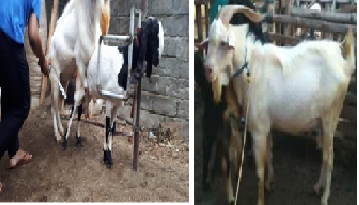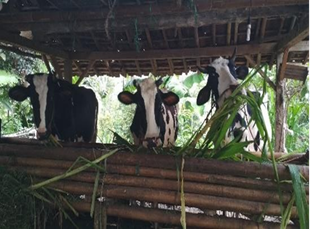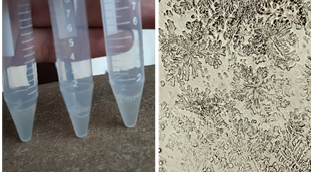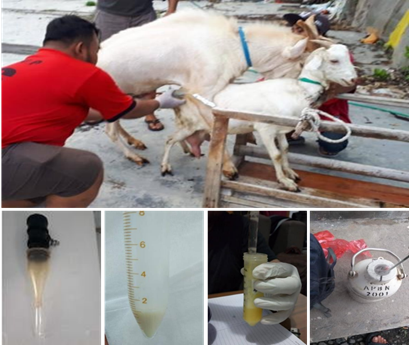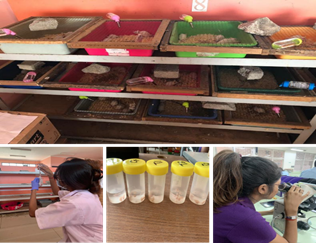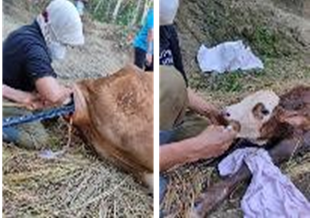Performance of pre-breeding cycle-staging techniques in bitches: Clinical comparability of vaginal cytology and progesterone assay
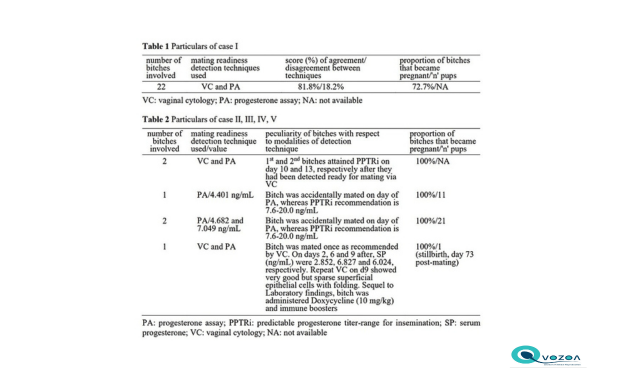
Downloads
Accurate timing of insemination (mating) remains a critical challenge in the reproductive management of bitches. In spite of technical advances in vaginal cytology (VC) and serum-progesterone (SP) assay, the challenges appeared not to have abated. Five clinical scenarios involving VC and SP are presented, aimed at investigating technique-performance and creating more robust awareness on application of SP titers obtained using a fluorescence immunoassay kit having 7.6–20.0 ng/mL as predictable-progesterone-titer-range-for-insemination-(PPTRi). Number of bitches, insemination-readiness-detection-technique(s) (IRDT), score (%) of agreement/disagreement between Insemination-readiness-detection techniques (SABT) for peculiarities of bred bitch(es) (PBB), proportion of bitches that became pregnant confirmed by relaxin assay and, number of pups littered were studied. Results obtained for number of bitches, IRDT, SABT or PBB, relaxin and number of pups littered, respectively were: 22, VC-SP, 81.8%/18.2%, 72.7% and, NA (i.e. not-available) (case I); 2, VC-SP, bitches mated after attaining PPTRi 10 and 13 days after been detected ready-for-mating via VC, 100%, and, 5 and 7, respectively (case II); 1, SP, bitch mated at SP of 4.401 ng/mL, 100% and, 11 (case III); 2, SP, first bitch mated at 4.682 ng/mL and the second at 7.049 ng/mL, 100% and, 9 and 12, respectively (case IV); 1, VC-SP, bitch mated once detected ready-for-mating by VC while SP at 24-hours post-mating was 2.852 ng/ mL, 100% and, 1 (case V). These findings suggest high-level agreement in accuracy of Insemination-readiness-detection between the two techniques, with none reflecting superiority. For better breeding successes, it is recommendable to inseminate earlier, during the peri-ovulation period.
Akinbote OR, Olanrewaju AO, Obafemi OM, Famakinde SA, Bolaji AA, Rabiu MB, Leigh OO. 2022. Advocacy for quantitative progesterone assay in breeding management of bitches. Ovozoa: J Anim Reprod. 11: 98-102.
Astudillo I, Aspee K, Palomino J, Peralta OA, Parraguez VH, De Los Reyes M. 2023. Meiotic development of canine oocytes from poly-ovular and mono-ovular follicles after in vitro maturation. Animals 13: 648.
Aydin I, Sur E, Ozaydin T, Dinc D. 2011. Determination of the stages of the sexual cycle of the bitch by direct examination. J Anim Vet Adv. 10: 1962-7.
England GC, Russo M, Freeman SL. 2013. The bitch uterine response to semen deposition and its modification by male accessory gland secretions. Vet J. 195; 179-84.
England G, Concannon PW. 2002. Determination of the optimal breeding time in the bitch: Basic considerations. In: PW Concannon, G England, J Verstegen and C LinderForsberg (Eds). Recent advances in Small Animal Reproduction. International veterinary information service, Ithaca, New York USA. Disponivel em;< http//www.ivis.org
Gurumyen GY, Omadevuaye TO, Polycarp TN, Tizhe EV, Adekunle LA, Usman AA, Jubril AJ, Antia RE, Taiwo VO. 2021. Gross and histopathological diagnosis of intra-luminal vaginal leiomyoma in an 8-year-old caucasian bitch: Case report. Nigerian Vet J. 42: 301-7.
Kunanusont N, Punyadarsaniya D, Ruenphet S. 2021. Accuracy and precision guidelines for optimal breeding time in bitches using in-house progesterone measurement compared with chemiluminescent microparticle immunoassay. Vet World 14: 585-8.
Labib FM, Mansour HH, Mahdy AB, Abdallah AA. 2018. Predicting the optimal time of breeding and the possible approaches for treatment of some estrus cycle abnormalities in bitches. Slov Vet Res. 55: 125-35.
Leigh O, Raji L, Diakodue E. 2013. Detection of standing heat in the bitches: Application of vaginal cytology. World J Life Sci Med Res. 3: 21-5.
Nesa LMNS, Trilaksana IGNB, Puja IK. 2022. Vaginal Cytology and receptivity to mating behavior of Kintamani bitch during proestrus to estrus phase. Int J Vet Sci Anim Husb. 7: 38-41.
Obafemi OM, Ugokwe IN, Yusuf A, Bolaji AA, Mustapha L, Famakinde SA, Agbugba LC, Oladipupo AA, Ibiam AE, Iyanda A, Adeyeye AA, Leigh OO. 2021. Insights from progesterone fertility tests: Vaginal mucus resistivity and cytology techniques for enhanced dog breeding in developing countries. Trop Vet. 39: 2-13.
Pavlo MS, Olexandri VH, Roman M. 2022. Determining the optimal insemination time of bitches. FAVE Sec Cienc Vet. 21: e0005.
Rijsselaere T, England GCW, Freeman SL, Soom AV, Maes D. 2014. Current knowledge on the transport and fate of spermatozoa in the reproductive tract of the bitch. Reprod Domest Anim. 49: 2-7.
Saint-Dizier M, Mahé C, Reynaud K, Tsikis G, Mermillod P, Druart X. 2020. Sperm interactions with the female reproductive tract: A key for successful fertilization in mammals. Mol Cell Endocrinol. 516: 110956.
Schmicke M, Urhausen C, Wolf K, Schmidt S, Günzel-Apel AR. 2016. Evaluation der mittels Chemilumineszenztest gemessenen Blut-Progesteronkonzentration bei der Hündin am Tag der Ovulation [Evaluation of the blood progesterone concentration in the bitch measured by chemiluminescence immunoassay at the day of ovulation]. Tierarztl Prax Ausg K Kleintiere Heimtiere. 244: 317-22. German.
Silva MLM, Oliveira RPM, Oliveira FF. 2020. Evaluation of sexual behavior and reproductive cycle of bitches. Braz J Dev. 6: 84186-96.
Copyright (c) 2025 Samuel Ayodele Famakinde, Oluropo Michael Obafemi, Tolulope Adeoye Ajayi, Olufisayo Oluwadamilare Leigh, Oreoluwa Raymond Akinbote, Adedamola O Olanrewaju, Deborah Boluwatife Ola, Oluwaseyi Oladiran Fakorede, Barakat Adedamola Salaudeen, Mutiat Busayo Rabiu

This work is licensed under a Creative Commons Attribution-ShareAlike 4.0 International License.
Ovozoa by Unair is licensed under a Creative Commons Attribution-ShareAlike 4.0 International License.
1. The journal allows the author to hold the copyright of the article without restrictions.
2. The journal allows the author(s) to retain publishing rights without restrictions
3. The legal formal aspect of journal publication accessibility refers to Creative Commons Attribution Share-Alike (CC BY-SA).
4. The Creative Commons Attribution Share-Alike (CC BY-SA) license allows re-distribution and re-use of a licensed work on the conditions that the creator is appropriately credited and that any derivative work is made available under "the same, similar or a compatible license”. Other than the conditions mentioned above, the editorial board is not responsible for copyright violation.





























